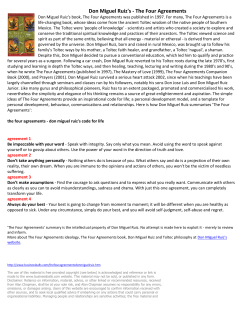
Document 233242
on the cover If current trends continue, an excess of weight will surpass smoking as the primary cause of preventable deaths in the U.S. Health experts, however, often overlook the best near-term strategy for stopping the obesity epidemic: behavior-modification methods that have been shown to change people’s eating and exercise habits. Illustration by Bryan Christie. February 2011 Volume 304, Number 2 78 feature s HEALTH 40 How to Fix the Obesity Crisis Although science has revealed a lot about metabolic processes that influence our weight, the key to success may lie elsewhere. By David H. Freedman space 48 Citizen Satellites Even a small research group can now afford to send its own science experiments into Earth orbit. By Alex Soojung-Kim Pang and Bob Twiggs SUSTAINABILIT Y 54The Blue Food Revolution New fish farms out at sea, and cleaner operations along the shore, could provide the world with a rich supply of much needed protein. By Sarah Simpson cognitive psychology 62 How Language Shapes Thought The languages we speak affect our perceptions of the world. By Lera Boroditsky BIOLOGY 66 The Inner Life of the Genome The way our genes are arrayed and move in the 3-D space of the nucleus turns out to profoundly 2 Scientific American, February 2011 sad0211Toc5p.indd 2 influence how they function, in both health and disease. By Tom Misteli ECOLOGY 74 A Friend to Aliens Ecologist Mark Davis thinks that his colleagues exaggerate threats from invasive species. Interview by Brendan Borrell ASTROPHYSICS 78 X-ray Vision Thanks to amazing mirrors, NASA’s NuSTAR telescope, scheduled to launch in 2012, will peer past clouds of dust to reveal hidden phenomena in the cosmos. By Fiona Harrison and Charles J. Hailey NEUROPROSTHETICS 80 Mind Out of Body Brain-wave control of machines will allow the wheelchair-bound to walk and portends a future of mind melds and thought downloads. By Miguel A. L. Nicolelis HISTORY OF SCIENCE 84 Jefferson’s Moose Thomas Jefferson waged a second revolution, fighting the image created by European naturalists of a degenerate America. By Lee Dugatkin Photograph by Floto + Warner 12/21/10 3:51:24 PM in brief Signals channeled directly from the brain can already control computers and other machines. Exoskeletons, full-body prosthetics, will ultimately connect directly to the brain as well. Brain-wave control of external prosthetics and computers portends an Age of Machines in which we transfer thoughts as if they were mental telegrams. 80 Scientific American, February 2011 sad0211Nico4p.indd 80 12/17/10 12:48:49 PM Miguel A. L. Nicolelis has pioneered the field of neuroprosthetics. He is Anne W. Deane Professor of Neuroscience at Duke University and founder of Duke’s Center for Neuroegineering. N e u r o p r o st h e t i c s Mind Out of Body In an exclusive excerpt from his new book, a pioneering neuroscientist argues that brain-wave control of machines will allow the paralyzed to walk and portends a future of mind melds and thought downloads A By Miguel A. L. Nicolelis were left to do the hard work of roaming the lmost every time one of my scientific manuscripts returned universe and, in some cases, seeking to annihifrom the mandatory peer-review process during the past late an entire alien race on behalf of their huthree decades, I had to cope with the inevitable recommenman masters. dation that all scraps of speculative thinking about our abilLet me present an alternative view on the ity to interface brains and machines should be removed coming Age of the Machines. After working and from the papers. More often than not, other neuroscientists thinking long and hard about the impact of who reviewed these papers before publication did not wish brain-wave-controlled robots, often called brainto entertain the notion that this research could lend support to more daring machine interfaces, I see a future filled with scientific dreams in the future. During those painful reckonings, I would fantablunt optimism and eager anticipation, rather size about the day when I could rescue those speculative ideas and liberate than one plagued by gloom and calamity. Perthem for others to consider and contemplate. Our progress in the laboratory haps because so little about the true dimenmeans that the time to tell others has finally arrived. While I have been confronting the ultraconservative culture sions of this future can be conceived with certainty, I feel an inof academia, a number of science-fiction writers and movie di- tense calling to embrace the amazing opportunities that freeing rectors have been speculating unreservedly and at times over our brains from the limits of our terrestrial bodies can bring to indulging in the excesses of their fertile imaginations. During our species. In fact, I wonder how anyone could think otherwise, 2009 alone, two Hollywood mega productions, Surrogates and given the tremendous humanistic prospects that brain-machine Avatar, portrayed the stereotype of scientists controlling, harm- interface research promises to unleash. Through this “liberation” of the human brain from the physiing, killing and conquering people with their technological wizardry. In these films, brain-machine interfaces allowed human cal constraints imposed by the body, the disabled may rise from beings to live, love and fight by proxy. Their full-body avatars wheelchairs. But there is more. An era of neurosocial networking looms. Forget texting and Twitter. In this brain-centered future, you may be able to communicate brain to brain directly to your Excerpt adapted from Beyond Boundaries: The New Neuroscience of Connecting Brains co-worker in the next cubicle or to millions of followers in a new with Machines—and How It Will Change Our Lives, by Miguel Nicolelis. To be published March 15 by arrangement with Times Books, an imprint of Henry Holt and Company, medium, which I call a brain net. Flickr will be ancient history. That mental image of the rosy dawn or your hometown team LLC. Copyright © 2011 by Miguel Nicolelis. Illustration by Kenn Brown, Mondolithic Studios sad0211Nico4p.indd 81 February 2011, ScientificAmerican.com 81 12/17/10 12:49:41 PM winning the World Series will be relayed via radio-frequency brain waves directly to a pocket pentabyte drive. Which Robo Suit Should I Wear? Exoskeleton, a prosthetic that allows the disabled to walk, may one day be controlled by brain waves. tion to the cerebral cortex, the brain’s master command center. To realize the vision of a brain-machine-interface exoskeleton for the handicapped, we will need still more advanced technology. It will require a new generation of high-density microelectrodes that can be safely implanted in the human brain and provide reliable, long-term simultaneous recordings of the electrical activity of tens of thousands of neurons, distributed across multiple brain locations. Indeed, to make brain-machine interfaces medically practical and affordable, these large-scale recordings of brain activity will have to remain stable for at least a decade without any need for surgical repair. Custom-designed neurochips also will be implanted permanently, which will allow us to condition and process the brain’s electrical patterns into signals capable of controlling the exoskeleton. To reduce the risk of infection and damage to the cortex, these neurochips will have to incorporate low-power, multichannel wireless technology capable of transmitting the collective information generated by thousands of individual brain cells to a wearable processing unit, about the size of a modern cell phone. This unit will be responsible for running computational models of the brain’s inner workings and designed to optimize immediate extraction of electrical brain signals that initiate movement. The populations of neurons we sample to feed into this brainmachine interface will be distributed across multiple brain areas. Digital signals extracted from the raw electrical signals from the part of the brain that controls movement will prompt moving parts distributed across the joints of the robotic exoskeleton to budge. Neural signals will interact with the robo skeleton to mimic the functions of the human spinal cord. These commands will permit the patient to take one step and then another, slow down or speed up, bend over or climb a set of stairs. All the while, brain and machine will continue to send to and receive from each other in the background in a seamless dialogue. These techniques will create a continuous interplay between brain signals and robotic reflexes. Paul Sakuma AP Photo yet current musings about downloading or simulating an entire brain into a computer will never come to pass. The essence of our personalities—what makes Nelson Mandela, say, such a special human being—will never transfer to a hard drive. But experiments in rodents, monkeys and humans have shown that brains can be directly linked to machines in a laboratory setting. Based on these findings, I foresee an exciting future. In the next two decades brain-machine interfaces, built by connecting large chunks of our brains through a bidirectional link, may be able to restore humanity to those who have succumbed to devastating neurological diseases. The interfaces will likely begin to bring back neurological function to the millions of people who can no longer hear, see, touch, grasp, walk or talk by themselves. Those people may even achieve the unimaginable task of conversing through brain waves alone. An international research consortium, the Walk Again Project, which I co-founded, offers a first glimpse of this future. Conceived a few years ago after my group demonstrated the feasibility of linking living brain tissue to a variety of artificial tools, the project aims to develop and implement the first brain-machine interface capable of restoring full-body mobility to patients suffering from severe body paralysis, whether it resulted from traumatic lesions of the spinal cord or from a neurodegenerative disorder. To accomplish this goal, we are engineering a neuroprosthetic device that will allow paralyzed patients to use a brain-machine interface to control the movements of a full-body exoskeleton. This “wearable robot” will give the patients voluntary control over upper and lower limbs and will sustain and carry their bodies. We are basing this feat of neuroengineering on neurophysiological principles, derived empirically from our brain-machine-interface experiments with rhesus monkeys and many other animals. In these experiments, a monkey named Aurora learned how to transmit through a brain-machine interface her thoughts of where a computer cursor should be positioned, a skill that became as natural and fluid as doing the same task with a joystick. We then performed the same experiment successfully in patients suffering from advanced Parkinson’s disease. Still later, a monkey at my laboratory at Duke University learned how to transmit brain signals thousands of miles over the Internet to control the leg movements of a robot in Japan. Now we have started going in the opposite direction, conveying direct signals into a monkey’s cerebral cortex, letting the animal know that the “treat” of a food pellet resides in one box and not another. One of our next endeavors will allow one monkey to communicate the location of food to another. New-generation neuroprosthetics will require communication both to and from the outside world. The brain of the wearer will need to instruct a bionic foot, not only to ascend to the next step of a staircase but also to receive feedback that the prosthetic has actually contacted a hard surface before sending out a command to bring up the other foot. With input-output links to the external world now in place, we will stand at the portals of a bionic future. Brain interfaces will merge with the most sophisticated robotic limbs now in testing. Robotic arms and legs will snap on like LEGO blocks to a biosynthetic torso. This robo suit, or exoskeleton, draped over the limp body of its wearer, will maintain a direct connec- 82 Scientific American, February 2011 sad0211Nico4p.indd 82 12/17/10 12:49:51 PM the end of a long and life-threatening journey, he found himself staring at the bright, sandy shores of a new world. Could such a complete liberation of the brain allow us to blur, or even eliminate, the once inexpugnable physical borders that define an individual human being? Could we one day, in a remote future, experience what it is to be part of a conscious network of brains, a collectively thinking true brain net? Assuming this brain net became real, could the individual participants not only communicate back and forth with one another just by thinking but also vividly experience what their counterparts feel and perceive, as they seamlessly adhere to this true “mind meld”? Very few people today would likely choose to venture into these unknown waters, but it is impossible to know how coming generations will react if presented with the opportunity to experience such a literally mind-boggling experience. The prospect of Neural Apps Accepting that all these stunning scenarios could actually what could happen within a few decades if we master technologies that allow humans to utilize the electrical activity of their take place and taking for granted that such a collective mind brains to interact with all kinds of computational devices? From meld could become consensually accepted as an ethical way tiny personal computers that we carry with—or possibly with- through which future generations interact and share their huin—us to remote distributed networks aimed at mediating our manity, could these descendants of ours wake up one morning digital social interactions, our daily lives will look and feel much and simply realize that they had peacefully given birth to a different human species altogether? It is not inconceivable that different from what we are accustomed to today. For starters, interacting with the operating system and soft- our progeny may indeed muster the skills, technology and ethware of one’s personal computer will likely become an embod- ics needed to establish a functional brain net, a medium through ied adventure, as our brain activity is used to grab virtual ob- which billions of human beings consensually establish tempojects, trigger programs, write memos and, above all, communi- rary direct contacts with fellow humans through thought alone. What such a colossus of collective consciousness may look cate freely with other members of our favorite brain net, a considerably upgraded version of online social networking. The like or feel like, neither I nor anyone in our present time can fact that Intel, Google and Microsoft have already created their possibly conceptualize. It may, without our expecting it, proffer own brain-machine divisions shows that this idea is not far- the ultimate human perceptual experience: to discover that fetched. The main obstacle: development of a noninvasive each of us is not alone, that our most intimate thoughts, experimethod to sample the brain activity needed to make such brain- ences, anguish, passions and desires, the very primordial stuff machine interfaces a reality. I feel confident that a solution will that defines us as humans, can be shared by billions of our brothers and sisters. be found in the next 20 years. It takes just a minor leap of imagination to think that, in the At that time, what may sound unimaginable will become routine, as augmented humans make their presence felt in a variety midst of their newly acquired wisdom, our progeny may also decide to cross yet another Rubicon in our species’ epic of remote environments, through avatars and artifiwatch a video of history and strive to document, for the benefit of fucial tools controlled by thought alone. From the depths mind control ture generations and the posterity of the cosmos, the of the oceans to the confines of supernovae, even to ScientificAmerican.com/ richness and diversity of their human inheritance. the tiny cracks of intracellular space inside our own feb2011/mind-control Such an inestimable treasure could only be assembodies, the human reach will finally catch up to our species’ voracious ambitions to explore the unknown. It is in this bled, I suggest, by preserving the irreplaceable, first-person narcontext that I envision our brains will eventually complete their rative of each and every single human lifetime story by transferepic journey from the obsolete terrestrial bodies they have in- ring our memories to a digital storage medium. This action would habited for millions of years and, through the use of bidirection- serve to protect the unique account of our mortal existence that, al, thought-driven interfaces, operate a myriad of nanotools that after a brief temporary stay in one’s mind, is irremediably lost at will serve as our new eyes, ears and hands in the many tiny the end of our lives, in a rare wasteful lapse of nature. Before my own career is over, I hope that endeavoring to dream worlds crafted by nature. On the scale of the very large, we will likely be able to operate big will help realize this vision—a trajectory that envisages a pathremotely controlled envoys and ambassadors, robots and airships way from today’s brain control of computers to eventual exoskeleof many shapes and sizes, sent on our behalf to explore other tons to perhaps even neurotexting. It would be an amusing coda planets and stars in distant corners of the universe and capable of to my time in the trenches of science to finally answer a querulous academic reviewer by seeding his auditory cortex with just placing strange lands and scenery at our mental fingertips. With each step in our explorations, we will continue to assimi- the kind of reply I have been meaning to convey for decades. late the tools created by our descendants for these mind voyages as further extensions of the self, defining a view of the world and a more to explore way of interacting with it that goes far beyond anything we can Controlling Robots with the Mind. Miguel A. L. Nicolelis and John K. Chapin in Scientific imagine today. This thought brings me an enormous feeling of American, Vol. 287, No. 4, pages 46–53; October 2002. elation and awe, which resembles the profound emotion that a Seeking the Neural Code. Miguel A. L. Nicolelis and Sidarta Ribeiro in Scientific American, Portuguese sailor, 500 years ago, may have experienced when, at Vol. 295, No. 6, pages 70–77; December 2006. I also envision force and stretch sensors, distributed throughout the exoskeleton, that will generate a continuous stream of feedback signals for artificial touch and proprioception (sensing of the suit’s positioning) to update the patient’s brain. Electrical microstimulators will deliver signals to the cortex. Alternatively, optical signals will activate light-sensitive ion channels deployed directly into the patient’s cortex. Based on our prior lab experiments with brain-machine interfaces in monkeys, I expect that after a few weeks of interaction, the patient’s brain will completely incorporate the entire exoskeleton as a true extension of the person’s body image. At that point, the patient will be able to use the brain-interface-controlled exoskeleton to move freely and autonomously around the world. February 2011, ScientificAmerican.com 83 sad0211Nico4p.indd 83 12/17/10 12:49:57 PM
© Copyright 2025














